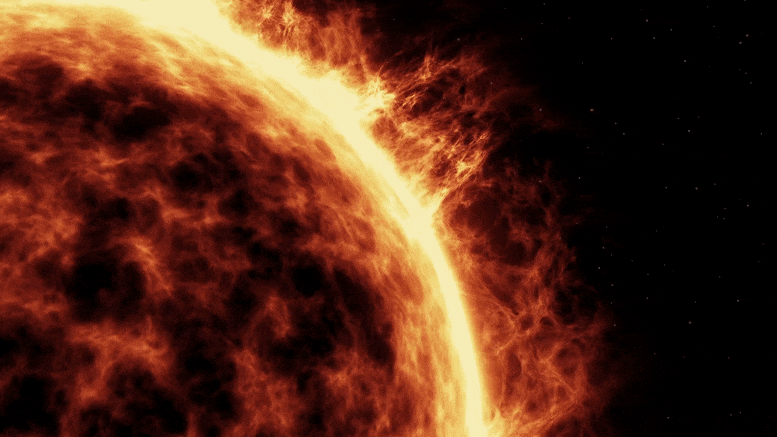Resolviendo una controversia de una década sobre la composición de nuestra estrella
8 min read
Los astrónomos finalmente han resuelto el conflicto entre la estructura interna del Sol determinada a partir de las oscilaciones solares y la estructura derivada de la teoría fundamental de la evolución estelar.
Nuevos cálculos del espectro solar resuelven una controversia de una década sobre la composición de nuestra estrella.
Aunque nuestro sol está mucho más cerca que cualquier otra estrella del universo, todavía tiene sus misterios. Después de todo, todavía está a 93 millones de millas (150 millones de kilómetros) de la Tierra y solo tenemos una perspectiva estrecha. Además, su superficie está caliente, su atmósfera aún más caliente y sus partículas se proyectan constantemente a alrededor de 1 millón de millas por hora. No es de extrañar que todavía estemos haciendo nuevos descubrimientos.
De hecho, los astrónomos acaban de resolver la crisis de abundancia solar de una década: el conflicto entre la estructura interna del Sol determinada a partir de las oscilaciones solares (heliosismología) y la estructura derivada de la teoría fundamental de la evolución estelar, que a su vez se basa en mediciones de la composición química del Sol actual. Nuevos cálculos de la física de la atmósfera del Sol dan resultados actualizados de las abundancias de diferentes elementos químicos, que resuelven el conflicto. En particular, el Sol contiene más oxígeno, silicio y neón de lo que se pensaba anteriormente. Los métodos empleados también prometen estimaciones mucho más precisas de las composiciones químicas de las estrellas en general.
¿Qué haces cuando un método probado para determinar la composición química del Sol parece entrar en conflicto con una técnica innovadora y precisa para mapear la estructura interna del Sol? Esta era la situación a la que se enfrentaban los astrónomos que estudiaban el Sol, hasta los nuevos cálculos que ahora han sido publicados por Ekaterina Magg, Maria Bergemann y sus colegas, que resuelven la aparente contradicción.

Espectro del Sol, tomado con el espectrógrafo NARVAL de muy alta resolución instalado en el Telescopio Bernard Lyot, Observatorio Midi-Pyrénées. Dichos espectros, en particular las propiedades de las líneas de absorción oscuras claramente visibles en esta imagen, permiten a los astrónomos inferir la temperatura y la composición química de una estrella. Crédito: © M. Bergemann / MPIA / [email protected]
El método probado en cuestión es el análisis espectral. Para determinar la composición química de nuestro Sol, o de cualquier otra estrella, los astrónomos recurren regularmente a los espectros: el desglose de la luz similar al arco iris en sus diferentes longitudes de onda. Los espectros estelares contienen líneas oscuras nítidas, notadas por primera vez por William Wollaston en 1802, redescubiertas por Joseph von Fraunhofer en 1814 e identificadas como signos reveladores que indican la presencia de elementos químicos específicos por Gustav Kirchhoff y Robert Bunsen en la década de 1860.
datos sobre el sol
- Tipo: estrella de secuencia principal tipo G (G2V)
- Tipo informal: enana amarilla
- Edad: ~4.500 millones de años
- Volumen: 1,3 millones de veces el de la Tierra
- Temperatura central: 27 millones de grados[{” attribute=””>Fahrenheit (15 million degrees Celsius)
- Distance From Earth: 93 million miles (150 million kilometers)
- Distance From Galactic Center: 26,000 light years
Pioneering work by the Indian astrophysicist Meghnad Saha in 1920 related the strength of those “absorption lines” to stellar temperature and chemical composition, providing the basis for our physical models of stars. Cecilia Payne-Gaposchkin’s realization that stars like our Sun consist mainly of hydrogen and helium, with no more than trace amounts of heavier chemical elements, is based on that work.
The underlying calculations relating spectral features to the chemical composition and physics of the stellar plasma have been of crucial importance to astrophysics ever since. They have been the foundation of a century-long progress in our understanding of the chemical evolution of the universe as well as of the physical structure and evolution of stars and exoplanets. That is why it came as something of a shock when, as new observational data became available and provided an insight into the inner workings of our Sun, the different pieces of the puzzle apparently did not fit together.
The modern standard model of solar evolution is calibrated using a famous (in solar physics circles) set of measurements of the solar atmosphere’s chemical composition, published in 2009. But in a number of important details, a reconstruction of our favorite star’s inner structure based on that standard model contradicts another set of measurements: helioseismic data, that is, measurements that track very precisely the minute oscillations of the Sun as a whole – the way that the Sun rhythmically expands and contracts in characteristic patterns, on time scales between seconds and hours.
Just like seismic waves provide geologists with crucial information about the Earth’s interior, or like the sound of a bell encodes information about its shape and material properties, helioseismology provides information about the interior of the Sun.
Highly accurate helioseismic measurements gave results about the Sun’s interior structure that were at odds with the solar standard models. According to helioseismology, the so-called convective region within our Sun where matter rises and sinks down again, like water in a boiling pot, was considerably larger than the standard model predicted. The speed of sound waves near the bottom of that region also deviated from the standard model’s predictions, as did the overall amount of helium in the Sun. To top it off, certain measurements of solar neutrinos – fleeting elementary particles, hard to detect, reaching us directly from the Sun’s core regions – were slightly off compared to experimental data, as well.
Astronomers had what they soon came to call a “solar abundances crisis,” and in search of a way out, some proposals ranged from the unusual to the downright exotic. Did the Sun maybe accrete some metal-poor gas during its planet-forming phase? Is energy being transported by the notoriously non-interacting dark matter particles?
The newly published study by Ekaterina Magg, Maria Bergemann and colleagues has managed to resolve that crisis, by revisiting the models on which the spectral estimates of the Sun’s chemical composition are based. Early studies of how the spectra of stars are produced had relied on something known as local thermal equilibrium. They had assumed that locally, energy in each region of a star’s atmosphere has time to spread out and reach a kind of equilibrium. This would make it possible to assign to each such region a temperature, which leads to a considerable simplification in the calculations.
But as early as the 1950s, astronomers had realized that this picture was oversimplified. Since then, more and more studies incorporated so-called Non-LTE calculations, dropping the assumption of local equilibrium. The Non-LTE calculations include a detailed description of how energy is exchanged within the system – atoms getting excited by photons, or colliding, photons getting emitted, absorbed or scattered. In stellar atmospheres, where densities are far too low to allow the system to reach thermal equilibrium, that kind of attention to detail pays off. There, Non-LTE calculations yield results that are markedly different from their local-equilibrium counterparts.
Maria Bergemann’s group at the Max Planck Institute for Astronomy is one of the world leaders when it comes to applying Non-LTE calculations to stellar atmospheres. As part of the work on her PhD in that group, Ekaterina Magg set out to calculate in more detail the interaction of radiation matter in the solar photosphere. The photosphere is the outer layer where most of the Sun’s light originates, and also where the absorption lines are imprinted on the solar spectrum.
In this study they tracked all chemical elements that are relevant to the current models of how stars evolved over time, and applied multiple independent methods to describe the interactions between the Sun’s atoms and its radiation field in order to make sure their results were consistent. For describing the convective regions of our Sun, they used existing simulations that take into account both the motion of the plasma and the physics of radiation (“STAGGER” and “CO5BOLD”). For the comparison with spectral measurements, they chose the data set with the highest available quality: the solar spectrum published by the Institute for Astro- and Geophysics, University of Göttingen. “We also extensively focused on the analysis of statistical and systematic effects that could limit the accuracy of out results,” notes Magg.
The new calculations showed that the relationship between the abundances of these crucial chemical elements and the strength of the corresponding spectral lines was significantly different from what previous authors had claimed. Consequently, the chemical abundances that follow from the observed solar spectrum are somewhat different than stated in previous analysis.
“We found, that according to our analysis the Sun contains 26% more elements heavier than helium than previous studies had deduced,” explains Magg. In astronomy, such elements heavier than helium are called “metals.” Only on the order of a thousandth of a percent of all atomic nuclei in the Sun are metals; it is this very small number that has now changed by 26% of its previous value. Magg adds: “The value for the oxygen abundance was almost 15% higher than in previous studies.” The new values are, however, in good agreement with the chemical composition of primitive meteorites (“CI chondrites”) that are thought to represent the chemical make-up of the very early solar system.
When those new values are used as the input for current models of solar structure and evolution, the puzzling discrepancy between the results of those models and helioseismic measurements disappears. The in-depth analysis by Magg, Bergemann and their colleagues of how spectral lines are produced, with its reliance on considerably more complete models of the underlying physics, manages to resolve the solar abundance crisis.
Maria Bergemann says: “The new solar models based on our new chemical composition are more realistic than ever before: they produce a model of the Sun that is consistent with all the information we have about the Sun’s present-day structure – sound waves, neutrinos, luminosity, and the Sun’s radius – without the need for non-standard, exotic physics in the solar interior.”
As an added bonus, the new models are easy to apply to stars other than the Sun. At a time where large-scale surveys like SDSS-V and 4MOST are providing high-quality spectra for an ever greater number of stars, this kind of progress is valuable indeed – putting future analyses of stellar chemistry, with their broader implications for reconstructions of the chemical evolution of our cosmos, on a firmer footing than ever before.
Reference: “Observational constraints on the origin of the elements: IV. Standard composition of the Sun” by Ekaterina Magg, Maria Bergemann, Aldo Serenelli, Manuel Bautista, Bertrand Plez, Ulrike Heiter, Jeffrey M. Gerber, Hans-Günter Ludwig, Sarbani Basu, Jason W. Ferguson, Helena Carvajal Gallego, Sébastien Gamrath, Patrick Palmeri and Pascal Quinet, 20 May 2022, Astronomy & Astrophysics.
DOI: 10.1051/0004-6361/202142971

“Increíble aficionado a la música. Estudiante. Empollón empedernido del café. Jugador. Especialista web aficionado. Pionero malvado de la cultura pop”.


